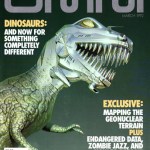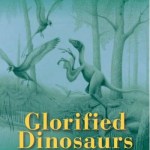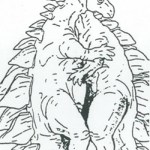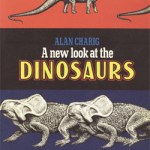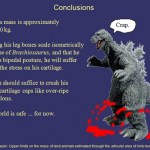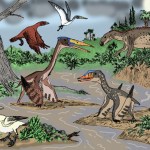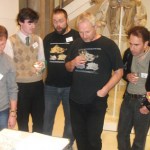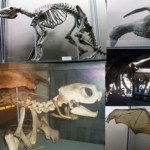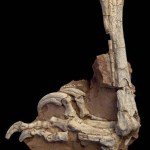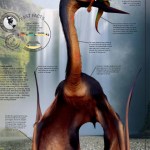Mesozoic dinosaurs
One of the strangest Mesozoic dinosaurs ever described has to be the African iguanodontian Lurdusaurus arenatus, named in 1999 for remains from the Lower Cretaceous Elrhaz Formation of Gadoufaoua, Niger (Taquet & Russell 1999). The Elrhaz Formation has also yielded the sail-backed iguanodontian Ouranosaurus, the rebbachisaurid sauropod Nigersaurus, the theropods Kryptops, Suchomimus and Eocarcharia, and the crocodilians Anatosuchus and Sarcosuchus. [Adjacent Lurdusaurus image by Luis Rey, used with permission.]
As is well known among dinosaur researchers, Lurdusaurus was first…
Steve Sweetman and I have just published a paper on a new maniraptoran theropod dinosaur from the Lower Cretaceous Wealden Supergroup of East Sussex, England (Naish & Sweetman 2011).
As you might know if you're a regular reader, much of my technical work has been devoted to Wealden theropods and I publish papers on them fairly regularly (recent articles: Benson et al. (2009), Naish (2010); see links below). I still have yet to publish one of my most significant contributions - the monographic description of the tyrannosauroid Eotyrannus lengi (the follow-up to the rushed and…
If asked "Why do giraffes have such long necks?", the majority of people - professional biologists among them - will answer that it's something to do with increasing vertical reach and hence feeding range. But while the 'increased vertical reach' or 'increased feeding envelope' hypothesis has always been the most popular explanation invoked to explain the giraffe's neck, it isn't the only one.
In 1996, Robert Simmons and Lue Scheepers argued that the giraffe neck functions as a sexual signal: they said that the necks of males are bigger and thicker than those of females, that the necks of…
Fossils demonstrate beyond any doubt that Mesozoic dinosaurs laid eggs, as of course do all dinosaurs today. But back during the 1960s, 70s and 80s - back when Robert Bakker and his idea about dinosaur biology were regularly featured in magazines and other popular sources - the scientific community was (sarcasm alert) delighted and enthralled by Bakker's proposal of sauropod viviparity.
Yes, mostly forgotten today is the idea that sauropod mothers were once suggested to give birth to a single, live, proportionally large baby, and to then engage in protracted parental care.
While Bakker is…
Well, the whole 'distributed denial of service' thing has done a pretty effective job of keeping me away from Tet Zoo entirely. No chance to blog, and not even the chance to look at the site at all - so, wow, thanks for keeping the protobats discussion going (97 98 comments... not bad). While those jolly nice people at ScienceBlogs tech support have just unblocked my IP address, it seems that lots of readers remain blocked - I see Tet Zoo sliding down the ratings a bit over on Nature Blog Network. Yikes, fifth place! Anyway, I'm just about ready to start deluging Tet Zoo with the enormous…
Welcome to part II of my musings on the 2010 blogging year. You'll need to have read the first part to make sense of it. The article you're reading now is extraordinarily long and I'd normally break up a piece of this length into two, three or even more separate articles. This year I want to get the birthday stuff out of the way as quickly as possible, however, so bear with me. Hey, you don't HAVE to read any of it. And so, off we go...
One of the bigger Tet Zoo-relevant issues of the year was the publication in September of Tetrapod Zoology Book One (Naish 2010a). Already I've seen several…
I read a lot of books in 2010, and mostly enjoyed all of them. Among my favourites was Luis Chiappe's Glorified Dinosaurs: The Origin and Early Evolution of Birds, and in the lengthy review article below (currently in press for Historical Biology) you can find what I thought of it. Note that Glorified Dinosaurs is not especially new (it appeared in 2007): it typically takes a few years for lengthy written reviews of large books to see completion (or, ha, it does in my case anyway).
One more thing to note: some of what I say here (e.g., about the relationship between birds and other…
Time to wrap up on the SJG special - make sure you see part I and part II first. Wow, I never thought I'd end up writing three long articles on this series of papers (hmm, a familiar theme). In the previous articles we looked at stegosaur systematics, and at Heinrich Mallison's work on the ranges of movement and posture of Kentrosaurus. This time round, we look at the papers that discuss preserved soft tissues, the possible role of the plates, and on feeding behaviour. Oh, and we finish up by looking at some other stuff too...
As I said before, the papers I'm discussing here appeared last…
If you read the previous article on stegosaurs you'll know that a collection of papers devoted to examination of this fascinating group appeared last year (2010) in a special issue of Swiss Journal of Geosciences (SJG from hereon). These papers resulted from a meeting held at the Sauriermuseum Aathal, Switzerland, in June 2009 (Billon-Bruyat & Marty 2010). Last time round, we looked at the papers on stegosaur systematics and diversity. Here, we begin a look at the remaining papers: they cover such subjects as athleticism and posture, possible feeding behaviour, soft tissue preservation…
Among the most iconic and remarkable of dinosaurs are the stegosaurs, a mostly Jurassic group of thyreophorans famous for the rows of spikes and plates that decorated their necks, backs and tails [somewhat inaccurate Stegosaurus stenops shown below. I did it many years ago].
As I'm fond of saying, the stegosaur we know best - Stegosaurus - is an atypical member of the group. It's particularly large and possesses lots of plates and but a few spikes. Stegosaurus may also be unusual in lacking shoulder spikes (aka parascapular spines), but this is less clear that it used to be since the '…
As you'll know if you have your fingers on the throbbing pulse of dinosaur-related publications, the massive, incredibly pricey volume published by the Geological Society of London, and resulting from the 2008 meeting History of Dinosaurs and Other Fossil Saurians, now exists in dead-tree form. It's titled Dinosaurs and Other Extinct Saurians: A Historical Perspective and (in my totally unbiased opinion) is a definite must-see* for anyone interested in the historical side of Mesozoic reptile research. Here are thoughts and comments on some of the contents.
* I initially wrote 'must have',…
My three-part series on the 'explosion of Iguanodon' is now complete and up on the Scientific American guest blog: part I is here, part II here, and part III here. Part III wraps things up and looks briefly at the social inertia that has held back our understanding of Iguanodon sensu lato, and also at the fact that some of the new names are unlikely to stand the test of time [the composite image above combines Greg Paul's illustrations of (at right, top to bottom) I. bernissartensis, Dollodon and Mantellisaurus, the skull of Dakotadon (at top left), and David Norman's skeletal reconstruction…
Part I of a three-part series on the 'explosion of Iguanodon' starts today at the Scientific American guest blog. This first part covers the background before looking at Altirhinus, Owenodon, Mantellisaurus and Dollodon - and there's lots more to come. Please head on over, and be sure to do your commenting there, not here. Thanks.
[composite image above includes colour restorations by Steveoc 86 (from Wikipedia) and skull reconstructions by Greg Paul ©, used with permission)].
The time has come to recycle this Tet Zoo classic, dating to February 2007 (it's actually one of the oldest of Tet Zoo ver 2 articles). I've updated it a bit and have included new pics - enjoy! [image below from Kaiji anatomical drawings.. read on for discussion].
To begin with, let's get things straight and admit up front that Godzilla is not a real animal, nor was it ever. It's an unfeasibly big late-surviving dinosaur (belonging to the hypothetical taxon Godzillasaurus, according to some), mutated by radiation, with a radioactive heart. Godzilla is virtually impervious to other gigantic…
Among one of many interesting and perplexing Mesozoic fossil assemblages is that known from Cornet, Romania. I've been really interested in this collection of archosaur remains - currently housed at the Tarii Crisurilor Museum, Oradea - ever since I first heard about it in the 1990s, and recently I've been lucky enough to work with Gareth Dyke, Michael Benton and Erika Posmosanu in re-evaluating the more controversial of the Cornet fossils: namely, those claimed to represent a bizarre and motley assortment of Mesozoic birds and pterosaurs. Our paper on these fossils has just been published…
In the previous article on the 58th Symposium on Vertebrate Palaeontology and Comparative Anatomy (SVPCA), held in Cambridge, UK, I discussed some of the work that was presented on stem-tetrapods and sauropods. This time round, we look at more Mesozoic stuff - pterosaurs in particular - before getting on to Cenozoic mammals.
Steve Sweetman presented the first outing of a new miniscule maniraptoran theropod that he and I have been working on. When it gets published, nothing will ever be the same again (massive hyperbole fully intended: Steve's talk was more to do with salamanders, anurans…
I said I wouldn't do any conferences this year. But I lied, and have recently returned from the 58th Symposium on Vertebrate Palaeontology and Comparative Anatomy (SVPCA), this year held once again in Cambridge, UK. Compared to the enormous, sprawling SVP (= Society of Vertebrate Paleontology) meeting with its numerous concurrent sessions (last year held in England, but usually held in North America), SVPCA is tiny and tidy. So, ok, there's less content, but at least you get to talk to everyone you want to, and to go to all the talks. As usual, I had an excellent time and extend warm thanks…
The last few weeks have been pretty exciting for people interested in theropod dinosaurs.... but then, you could say this about most weeks: new theropods are constantly being published.
Last week saw the publication of the weird, functionally two-fingered, short-footed maniraptoran Balaur bondoc from the latest Cretaceous of the HaÅ£eg Basin in Romania (Csiki et al. 2010) [left foot of Balaur shown here, from BBC News]. When Balaur was alive, the Hateg region was an island, so this was another of those weird, island-dwelling dinosaurs we've often hoped would exist. I have a vested personal…
Another book with my name on it has just appeared. Again it's a kid's book: Dorling Kindersley's Know It All (Baines 2010) - a fantastically well illustrated, fact-packed encylopedia of everything science (and the successor to the highly successful 2009 Ask Me Anything). It's a multi-authored book (authors: Simone Bos, Julie Ferris, Ian Graham, Susan Kennedy, Darren Naish, Jim Pipe, Carole Stott and John Woodward). My section - titled 'Dinosaurs' - isn't just on dinosaurs; it also includes spreads on Palaeozoic tetrapods, ichthyosaurs, pterosaurs, Pleistocene mammals, and hominids. Does it…
Lately I've become quite fond of those really weird depictions of fossil animals that were utterly, utterly wrong, yet somehow managed to persist in the literature for decades. Last time round, we saw how the meme of the 'demonic Quetzalcoatlus' passed from artist to artist, and had its genesis in a single, speculative illustration. Here's another example of the same sort of thing: during the 1970s, 80s and 90s the diplodocid sauropod Barosaurus was repeatedly depicted as a very, very strange beast...
Above is the oldest of these renditions I've been able to find: it comes from the multi-…



